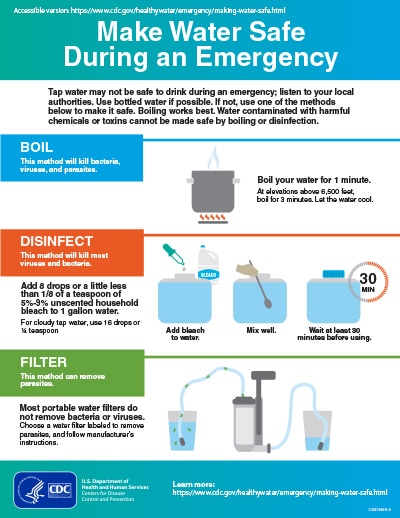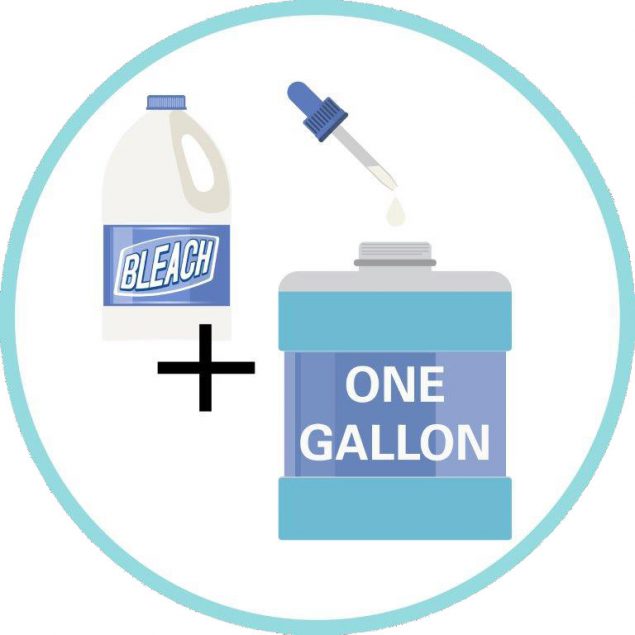Having access to clean and safe drinking water is essential for keeping your body healthy. Unfortunately, water can become contaminated with bacteria and other germs that can make you very ill. To protect your health, it is important to learn how to disinfect drinking water. In this article, you will learn the steps to take to make sure your drinking water is safe to consume.
The process of properly disinfecting drinking water can be easy to understand and apply. With the right information and materials, anyone can make sure their drinking water is clean and safe for consumption. In the following sections, you will find out exactly how to disinfect drinking water and the materials you will need.
Disinfecting drinking water is a process of removing, deactivating, or killing disease-causing microorganisms, such as bacteria, viruses, and parasites. It is important for maintaining safe drinking water for consumption. You can disinfect drinking water by boiling, chlorination, ultraviolet radiation, and filtration.
- Boiling: The most effective way to disinfect water is by boiling it for one minute. This will kill the majority of microorganisms present.
- Chlorination: Chlorine can be used to disinfect water. You can purchase chlorine tablets or drops that can be added to the water to disinfect it.
- Ultraviolet radiation: Ultraviolet radiation can be used to disinfect water. This method does not require any chemicals and is effective for killing most microorganisms.
- Filtration: Filtration is an effective way to remove microorganisms from water. A number of different filters are available on the market that can be used to filter out microorganisms.

How to Disinfect Drinking Water?
Drinking water is an essential part of life and it is important to ensure that it is safe and free from any contaminants. Disinfecting drinking water is an easy and effective way to make sure that it is safe to consume. This article will provide a detailed overview of the steps involved in disinfecting drinking water.
Identifying the Source of Contamination
The first step in disinfecting drinking water is to identify the source of the contamination. This can be done by testing the water for various contaminants and determining what is causing the contamination. Once the source of the contamination has been identified, it is important to take steps to remove or reduce the contamination. This can include using filters, boiling the water, or using chemical disinfectants.
It is also important to note that certain contaminants may require special treatment. For example, water contaminated with lead or arsenic will require a specialized treatment method. Additionally, if the water is contaminated with bacteria or viruses, it may require a more intensive treatment process.
Using Chemical Disinfectants
Once the source of the contamination has been identified, the next step is to use chemical disinfectants to disinfect the water. Chemical disinfectants are widely available and can be used to effectively remove harmful contaminants from the water. Common chemical disinfectants include chlorine, iodine, and chlorine dioxide.
When using chemical disinfectants, it is important to follow the directions on the package. Typically, the water should be tested for the presence of the contaminant prior to adding the disinfectant. Depending on the contaminant, different amounts of the disinfectant may be needed. Additionally, the water should be allowed to sit for a period of time after the disinfectant has been added to ensure that the contaminant has been effectively removed.
Using Boiling
Boiling is another effective method of disinfecting drinking water. Boiling can kill most bacteria and viruses, making it a reliable and safe method of disinfection. To effectively disinfect the water, it should be brought to a rolling boil for 1-3 minutes.
It is important to note that boiling may not be effective against certain contaminants, such as lead or arsenic. Additionally, boiling can strip the water of certain minerals, making it less nutritious. For these reasons, it is important to use chemical disinfectants when possible.
Storing Disinfected Water
Once the water has been disinfected, it is important to store it properly in order to maintain its safety. Disinfected water should be stored in a clean, airtight container. It should be kept away from direct sunlight and other sources of contamination. Additionally, it should be used within a few days, as the disinfectant may become less effective over time.
Testing Disinfected Water
Finally, it is important to test the water periodically to ensure that it is safe to drink. This can be done by testing the water for contaminants, or by using a home water testing kit. If the results of the test indicate that the water is contaminated, it should be re-treated or discarded.
By following the steps outlined above, it is possible to effectively and safely disinfect drinking water. This is an important step in ensuring that all drinking water is safe to consume.
Frequently Asked Questions
The safety of drinking water depends on how it is treated and stored. Knowing how to disinfect drinking water can help keep you and your family healthy.
What is the best way to disinfect water?
Boiling is the most effective way to disinfect water. Boiling water for at least 1 minute will kill most types of disease-causing organisms. It is important to let the water cool before drinking it. Boiling is generally the best way to make sure your water is safe to drink.
Another way to disinfect water is to use chlorine or iodine. Chlorine and iodine are both effective ways to make sure your water is safe to drink, but they can leave an unpleasant taste. To make sure the water has been treated properly, you should follow the instructions on the container of chlorine or iodine.
What are some other ways to disinfect water?
Ultraviolet (UV) light can also be used to disinfect water. UV light is a safe and effective way to kill microorganisms in water. It does not add any chemicals to the water and does not leave a bad taste. UV light can be used to disinfect water in a variety of settings, such as in a home, business, or campground.
Distillation is another method that can be used to disinfect water. Distillation removes impurities from water by boiling it, then capturing the steam and condensing it back into liquid form. This process removes bacteria, viruses, and other contaminants from the water.
What should I do if I don’t have access to clean water?
If you don’t have access to clean, safe water, it is important to find an alternative source of water. You can find alternative sources of water by looking for sources of surface water, such as streams, lakes, and rivers. You should also look for sources of groundwater, such as wells or springs.
Once you have found an alternative source of water, it is important to treat it before drinking it. Boiling is the most effective way to make sure your water is safe to drink. If boiling is not an option, chlorine or iodine can be used to disinfect the water.
How do I store drinking water?
Storing drinking water is important to ensure it stays safe to drink. It is best to store drinking water in a clean, sealed container. Containers should be labeled with the date the water was collected, the source of the water, and the date it should be discarded.
It is important to keep the water away from direct sunlight and away from sources of contamination, such as sewage. It is also important to make sure the containers are tightly sealed and that the water is changed regularly.
What can I do to prevent water contamination?
The best way to prevent water contamination is to be aware of your surroundings. Avoid swimming or wading in water that may be contaminated with sewage or chemicals. Be aware of the sources of drinking water and always treat water before drinking it.
You can also take steps to protect your local water sources. Make sure to dispose of hazardous materials, such as motor oil, paint, and chemicals, properly. Be mindful of fertilizer and pesticide use and make sure to use them according to the instructions. Finally, make sure to properly maintain septic tanks and other wastewater systems.

Disinfecting Drinking Water with Chlorine
The need for clean, safe drinking water is a global issue that requires the attention of both individuals and industries. Disinfecting drinking water is a critical step in ensuring the safety of our water supply. There are several different methods of disinfection that can be used, and it is important to use the right method for the right situation. Chlorination, ozonation, UV radiation, and filtration are all effective methods of disinfecting drinking water.
Having access to clean and safe drinking water is essential for health and well-being. By utilizing the right methods of disinfection, we can ensure that drinking water is safe for consumption. Although the process of disinfection may be complex, it is a necessary step in protecting our water supply from potential contamination. Taking the time to understand the different methods of disinfection and the situations in which each method is best used is an important step in ensuring that our drinking water is safe.
